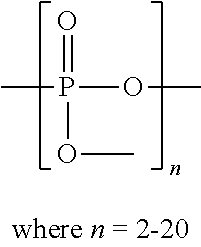Method for inhibiting the formation and deposition of silica scale in aqueous systems
- Summary
- Abstract
- Description
- Claims
- Application Information
AI Technical Summary
Benefits of technology
Problems solved by technology
Method used
Image
Examples
example 1
Stagnant Flask Study
[0041]This test was conducted using a 300 ppm test solution comprised of sodium silicate as SiO2, 80 ppm as Mg from magnesium sulfate, 100 ppm as total alkalinity from sodium bicarbonate, and 200 ppm as calcium from calcium chloride. The pH of the test solution was adjusted between 8.5-9.0. These test solutions were dosed with varying amounts of silica inhibitor and a constant amount (2 ppm) of 2-phosphonobutane-1,2,4-tricarboxylic acid (generally referred to as PBTC) as calcium carbonate inhibitor. Theses samples were thermostated at 60° C. Samples were withdrawn at various times and filtered through 2.5 micron filter prior to being analyzed for, silica, at pH 7-7.5. Sample 1 was 50 / 50 acrylic acid (AA) / polyethoxy methacrylate (HEMA) at 40% actives. Sample 2 was 40 / 60 AA / hydroxypolyethoxy allyl ether AAE at 40% actives. Sample 3 was 50 / 50 AA / AAE at 40% actives. Sample 4 was 60 / 40 AA / AAE at 40% actives.
Soluble Silica (ppm)TimeBlankSample 1Sample 2Sample 3Sample 4...
example 2
Pilot Cooling Tower Study
[0042]The following water was used in this study: Calcium (Ca) 12 mg / L; Magnesium (Mg) 4.0 mg / L; Potassium (K) 2.5 mg / L 2.6 mg / L; Silica (SiO2) 89 mg / L; Sodium (Na) 13 mg / L; Chloride (Cl) 4.3 mg / L; Nitrate (NO3) 1.6 mg / L; Sulfate (SO4) 2.4 mg / L; Chloride (CaCO3) 6.1 mg / L; Total Alkalinity (CaCO3) 71 mg / L; Conductivity at 25° C. 150 μS / cm; and pH @ 25° C. 8.3 pH Units.
[0043]The water was dosed with 20 ppm of the silica inhibitor of the invention and 20 ppm of the calcium carbonate inhibitor (PBTC). The water was recirculated in several heat exchanger loops and heat rejected through a cooling tower. In this process, the water was concentrated between 3-3.5 times (concentration factor) from the original water chemistry. The pH in the recirculating loop was recorded at ˜8.9. The delta temperature between the heat exchanger inlet and exit was 10° F. The water chemistry was monitored in the recirculating loop and the heat exchangers were monitored for any fouling....
PUM
 Login to View More
Login to View More Abstract
Description
Claims
Application Information
 Login to View More
Login to View More - R&D
- Intellectual Property
- Life Sciences
- Materials
- Tech Scout
- Unparalleled Data Quality
- Higher Quality Content
- 60% Fewer Hallucinations
Browse by: Latest US Patents, China's latest patents, Technical Efficacy Thesaurus, Application Domain, Technology Topic, Popular Technical Reports.
© 2025 PatSnap. All rights reserved.Legal|Privacy policy|Modern Slavery Act Transparency Statement|Sitemap|About US| Contact US: help@patsnap.com



